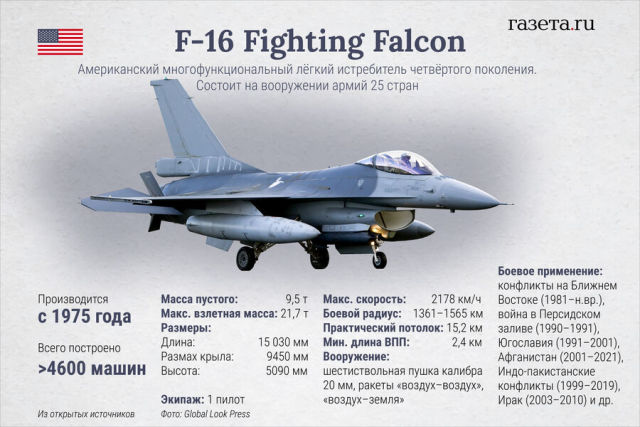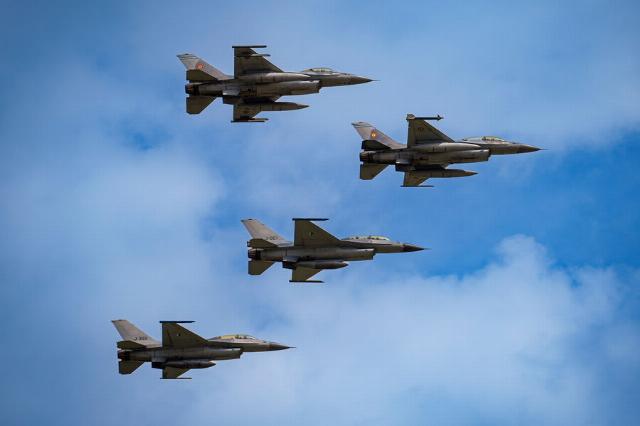Colonel Khodarenok: there will be no general battle in the air with the AFU in the summer
Today, both in the Russian and Ukrainian expert communities, there is a widespread opinion that this summer there will be a "general battle" of the special operation, which will determine its course and outcome. In connection with the supply of multifunctional F-16 fighters, observers are waiting for a decisive battle for supremacy in the skies of Ukraine. How the situation will develop in the near future, in the material of the military observer "Gazeta.En" by Mikhail Khodarenka.
Observers on both sides believe that in August-September 2024, a decisive battle for air supremacy (in connection with the supply of multifunctional F-16 fighters) will take place between Russia and Ukraine. This battle, according to many experts, will determine the entire further course of the special military operation and the positions of the parties in the course of further diplomatic resolution of the conflict. The upcoming confrontation between the Aerospace Forces of the Russian Armed Forces and the Air Forces of the Armed Forces of Ukraine is called an air battle. Let's see how accurate such a forecast can be. But first, let's clarify what the current situation is at the forefront.
Where are the rapid breakthroughs and tank raids?
The Russian public periodically has questions - why is the advance of the Russian troops during a special military operation sometimes only a few hundred meters per day, while the assault and capture of small regional centers take many months? For example, the fighting for Chas Yar began in April of this year (the city has not been taken so far), and the assault on Bakhmut lasted more than a year.

A few years ago, military science looked at the topics of advancing troops during combat operations somewhat differently. For example, according to recent standards, the depth of the immediate task during the offensive operation of the operational-strategic association reached 200 km. It was supposed to reach the boundary of the immediate task within 7-10 days with an average rate of attack of up to 20 km per day. And in general, it was assumed that the scope of front-line offensive operations (operations of operational and strategic associations) would be up to 400 km deep, up to 500 km wide, their duration would be 15-20 days, and the average pace of the offensive would reach up to 20 km per day.
By today's standards, such figures look absolutely incredible. What happened and how can we get out of this positional impasse?
In the not so distant past, the breakthrough of the enemy's defense was planned as follows: the breakthrough site was determined, a grouping of artillery with a density of 250-300 barrels per kilometer of the front was concentrated there, several ammunition shells were laid out on the ground, shock groups of troops were secretly concentrated from the enemy. Artillery in the course of artillery preparation simply ground the enemy's front edge to zero, attacking units and formations entered the area of the enemy's artillery units, then they were introduced into mobile front groups into battle and the pursuit of the defeated and randomly retreating enemy began.
The opposing sides saw through binoculars and stereo tubes only the leading edge of each other. In some cases, the data (by no means exhaustive) was obtained by air and military intelligence. Now it is almost impossible to act in this way. Possible plans, the timing of the offensive and the likely directions of attacks are determined by modern means of intelligence. It is difficult to conceal the activities of headquarters, troops, military installations and mislead the enemy about the composition, condition and actions of troops during preparation and already during hostilities or operations. Sudden actions by large groups of troops are practically excluded.
Ukraine, using the most modern intelligence tools of the United States and NATO member states, can establish the composition, time and areas of deployment of strike groups of the Armed Forces of the Russian Federation, identify the approach of reserves from the depths, their composition, areas of concentration, possible directions and timing of entry into battle, the composition of the aviation group, its basing and capabilities, the air defense system, identify the location of control points, communication nodes and the most important objects of the rear.
For this purpose, space intelligence (optoelectronic, detailed and survey, radio and radio engineering), intelligence, aerial (primarily with the help of UAVs) are used.
Personnel, weapons and military equipment are under almost continuous fire from barrage ammunition. Sometimes there are two or three attacking drones for each individual soldier. For these reasons, fighters avoid open spaces and actions in even small groups in every possible way.
Moreover, the escort of bomber drones by fighter drones is already being observed, and aerial battles between unmanned aerial vehicles of the warring parties are starting in the sky.
In such an environment, for example, it is simply unrealistic to concentrate 300 artillery barrels per kilometer of the front with up to five rounds of ammunition laid out on the ground. UAVs chase after each individual self-propelled artillery installation, and the counter-battery struggle of the enemy makes it problematic to place artillery, for example, at distances from four to six km from the front edge, required for reliable fire damage to the enemy. The combat use of artillery today looks like this - he quickly moved to a pre-selected firing position, fired several shots - and immediately retreated to a safe area. The combat use of tank troops looks about the same.
In order to reliably crack the enemy's defenses in such conditions and achieve operational-scale results, several important tasks must be solved.
Domination of the air and in the air
To begin with, it is necessary to win the battle on the air, that is, to gain superiority in the management of troops and weapons by disorganizing the electronic means and control of the enemy's troops, reduce the effectiveness of its combat means, weapons and intelligence, and ensure the stability of its electronic means. It is necessary to completely suppress the air defense control radio lines, radio navigation systems and VHF radio networks of control and guidance of aviation, artillery and missile forces, and enemy groups.
Today, this is one of the most important tasks, and without solving it, no offensive actions are possible. This requires numerous electronic warfare parts and connections equipped with the most modern technology.
In order to gain air superiority during an armed conflict, without which there can be no successful armed struggle, it is necessary, at least, to defeat the enemy's aviation and anti-aircraft groups.
To do this, in addition to strike aircraft, it is necessary to have jamming aircraft operating from the barrage zones. In addition, the combat composition of the VKS should include jamming aircraft located in the combat formations of the strike groups of operational-tactical and Long-range aviation, that is, aircraft comparable in their flight characteristics with OTA and DA combat vehicles.
To combat anti-aircraft missile and radio engineering units of the enemy (and their destruction is one of the most important tasks during the struggle for air supremacy), the VKS must have special units of operational and tactical aviation (multifunctional fighters), designed and trained exclusively to combat the enemy's air defense systems and air defense systems. These combat vehicles must be equipped with the most modern reconnaissance equipment and appropriate means of destruction.
Let us repeat once again, without air superiority in modern conditions, there can be no successful offensive actions on an operational and operational-strategic scale. Until Russian aviation reigns supreme in the skies over the whole of Ukraine, the advance of Russian combined arms units and formations will be measured in hundreds of meters and, at best, kilometers. A separate task, among other things, is the fight against UAVs of all types.
Will there be an "aerial Prokhorovka"?
Now a few words about the decisive battle for air supremacy, which, according to observers, should take place in the skies of Ukraine in the near future. Some experts sometimes call it a battle, sometimes an air battle. Sometimes they even agree that this confrontation in the air will become a direct clash between Russia and NATO in the airspace.
However, the number of F-16s that the Ukrainian Air Force will receive in the near future is likely to be small. Most likely, no more than two squadrons.

Image source: Alina Dzhus/"Newspaper.Ru"
And in this case, we cannot talk about "air battles" or "battles", let alone air operations. Most likely, the upcoming battles of Russian fighters and F-16s would be more correctly called air battles. And there can be no talk in such conditions about the struggle for air superiority on the Ukrainian side.
Despite the fact that the supply of F-16s will significantly enhance the combat capabilities of the Ukrainian Air Forces, it is clearly premature to say that these multifunctional fighters (and even in the amount that will be transferred to Ukraine) will lead to a turning point in the special operation in 2024. It's not a question of this summer.
As for the possible direct collision between Russia and NATO in airspace, which is claimed by a number of experts, the rumors are clearly exaggerated. At this stage, NATO does not intend to enter into an armed conflict in Ukraine.
If in August-September 2024 there are any events at the forefront that significantly change the situation during a special military operation, it will not be an "air battle" between the Su-30SM2 and the F-16. Yes, and
As a rule, victory in an armed confrontation remains with the army that, at the right moment and in the right place, will bring well-prepared strategic reserves into battle, ensuring their actions with coordinated efforts of all types of armed forces and branches of the armed forces. A general battle led to the desired result (and even then not always) in wars at best until the middle of the XIX century.
As you know, victory over a strong opponent in a large-scale armed confrontation cannot be achieved by a one-time strategic effort. So the talk of a "general battle" that will determine the course and outcome of its August-September this year looks like nothing more than the opinion of individual debaters. The reality on the battlefields is an order of magnitude more complicated.
The opinion of the author may not coincide with the position of the editorial board.
Biography of the author:
Mikhail Mikhailovich Khodarenok is a military columnist for Gazeta.Ru", retired colonel.
He graduated from the Minsk Higher Engineering Anti-Aircraft Missile School (1976), the Military Air Defense Command Academy (1986).
Commander of the S-75 anti-aircraft missile division (1980-1983).
Deputy commander of the anti-aircraft missile regiment (1986-1988).
Senior Officer of the General Staff of the Air Defense Forces (1988-1992).
Officer of the Main Operational Directorate of the General Staff (1992-2000).
Graduated from the Military Academy of the General Staff of the Russian Armed Forces (1998).
Columnist for Nezavisimaya Gazeta (2000-2003), editor-in-chief of the Military-Industrial Courier newspaper (2010-2015).
Mikhail Khodarenok

